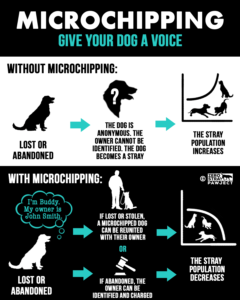Every year approximately 10 million pets are lost in the U.S. and millions of these lost animals find themselves in shelters and rescues hoping to be reunited with their families. For those pets who are microchipped, the chance of them being reunited with their families is greatly increased. According to the Journal of the American Veterinary Medical Association, dogs that are not microchipped are returned to their families 21.9% of the time, while microchipped dogs were returned 52.2% of the time. For cats, those without microchips are returned to their families at only a 2% rate, but with microchips, that jumps to 38%.
Thankfully it is easy to get your pet microchipped and to keep your data up-to-date through the microchip registry so if you find yourself in the horrifying situation of your pet being lost, you know that there is a better chance of being reunited with them.
What is a microchip?
A microchip is a small, electronic chip enclosed in a glass cylinder that is about the same size as a grain of rice. The chip is activated when a chip scanner is passed over the area of the animal where the chip is located. The scanner then transmits the identification number to the scanner. When this number is entered into microchip registration databases the owners contact information is provided so the veterinarian practice, shelter, or rescue can contact the owners.
How is the microchip placed in my pet?
No anesthesia or surgery is required. The microchip is injected under the skin using a hypodermic needle and is no more uncomfortable than a typical injection. Microchipping can be done by your veterinarian, your county animal shelter, or for income qualifying families at places like UCAN Clinic right here in Cincinnati.





